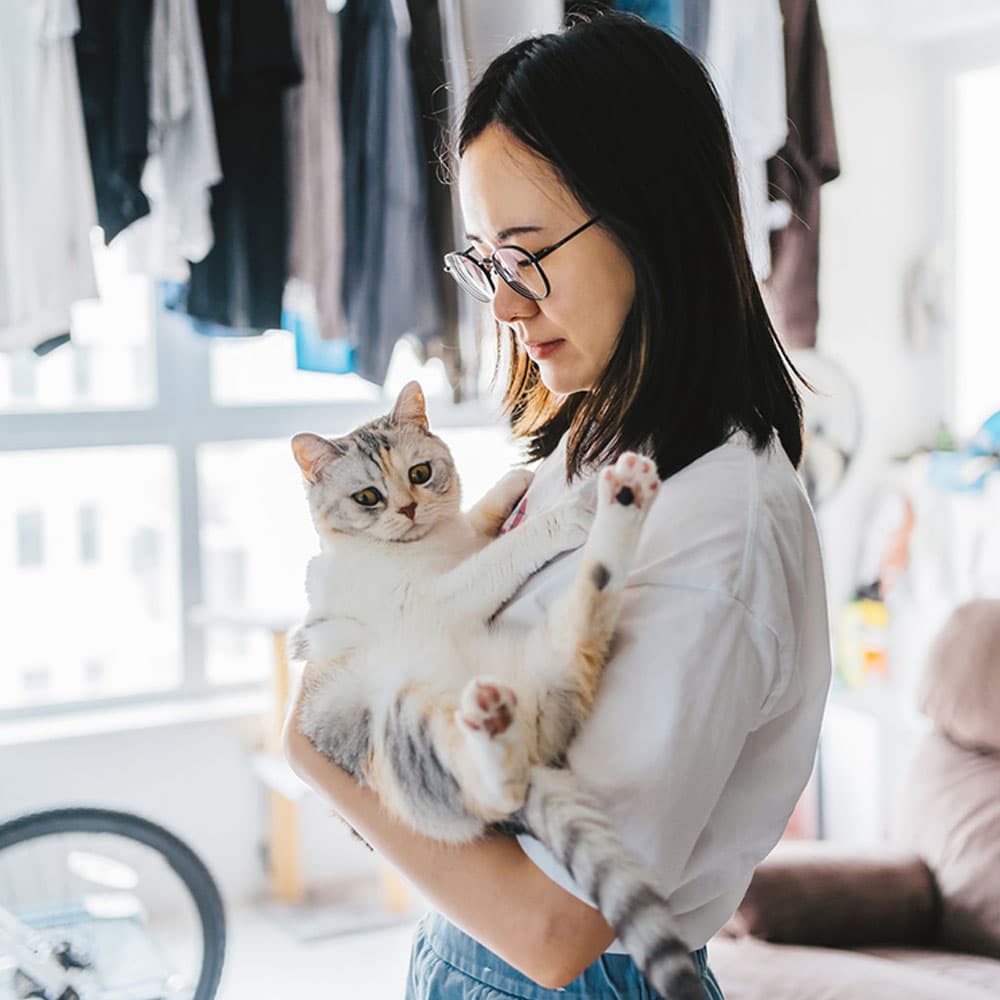How Much Do Cats Cost? Average Monthly Costs Explained
Thinking of adopting a cat? Learn more about the costs of pet parenthood.
Thinking of adopting a cat? Learn more about the costs of pet parenthood.
by Savannah Admire, | January 9, 2024

Heng Yu / Stocksy
Choosing to bring a cat into your home may seem simple, but it requires some budgeting and preparation. After all, cats can live over 17 years, so you’re looking at a long-term commitment. Fortunately, most pet parents (82 percent) say that pet spending brings them the most gratification of any of their monthly expenses. If you’re ready to join the ranks of cat parents, we’ve put together a guide on the cost of cat parenthood to help you prepare your budget (and yourself).
Adopting a cat from your local shelter or rescue can cost anywhere from $100 to $500, depending on your location and the organization’s fees. Fortunately, many adoption fees include spaying or neutering, up-to-date vaccines, and even microchipping, which can save you money on initial cat parenthood costs.
When you decide to adopt a cat, there are a lot of pet costs associated with purchasing supplies, adoption fees, and first vet visits. Below, we break down the range for each of these items, so you can get a better idea of how to budget for your new pet.
Adoption fee – $100 to $500
Vaccinations – $200 to $500
Spay/neuter surgery – $100 to $800
Microchip – $25 to $75, $50 on average
Initial supplies – $300 to $800:
Bed – $25 to $100
Scratching post – $20 to $135
Nail clippers – $5 to $30
Collar – $10 to $50
Toys – $5 to $30
Food and water bowls – $5 to $50
Carrying crate – $40
Litter box – $25
If you adopt a kitten, expect to make several visits to the vet during their first six months of life because kittens require multiple vaccinations to protect them from disease. You should also factor in the cost of getting a cat spayed, which can be pricey, so consider local spay and neuter clinics that offer the service at a lower cost.
Taking care of a cat involves a number of expenses, the biggest of which are medical care and food; cat parents should plan on investing in a healthy diet that meets their cat’s nutritional needs, and annual check-ups and vaccinations with a veterinarian. Cats also need litter, toys, and scratching posts. Unlike dogs, cats groom themselves and often don’t need regular grooming, but you may still want to invest in occasional grooming from a professional, especially with long-haired cats.
The table below breaks down what you can expect to spend on each item annually, so you can build a more comprehensive pet budget.
Expense | Average Cost |
Medical care | $100 to $300 |
Food | $120 to $500 |
Litter | $70 to $150 |
Toys and scratching posts | $20 to $75 |
Before you bring your new cat home, you’ll need to invest in some basic supplies to make sure they’re comfortable and entertained. Costs of pet spending can vary widely, depending on the brand and which products you choose to buy. For cats, figure on spending at least $100 on basic pet supplies, including:
Collar
Pet ID tag
Microchip
Cat bed
Bowls
Toys
Scratching posts
Carrying crate
Your first year of having a cat may cost anywhere from $750 to $2,675. As with any pet, first-year costs are higher because you have to purchase all the supplies you need to keep your cat happy and healthy.
The average cost of a cat per year is $1,149, according to the American Society for the Prevention of Cruelty to Animals (ASPCA) —but the amount you spend will depend on your cat’s age, health, and where you live. The annual essentials your cat needs, like food and cat litter, can cost anywhere from $325 to $1,600 each year. You may also want to purchase non-essentials, as many pet parents do, like fun toys and accessories, which can run anywhere from $1,100 to $3,600 per year.
To determine a budget for your new cat, add up the average cost of the items you need and err on the more expensive side to give yourself a bit of a buffer. Plan on spending at least $200 to $500 each year on your cat, including food.
Kittens are more expensive because they typically need a series of vet visits for vaccinations, more toys, larger collars as they grow, and training. They also tend to be the ones that claw up your couch cushions! The dollar ranges below also include food and average annual vet care costs:
$300 – Adult indoor-only cat (one to 10 years old)
$400 – Kitten (under one year old)
$500 – Senior indoor-only cat (10+ years)
$500 – Any age cat that goes outdoors
While you can certainly budget for the standard monthly expenses of cat parenthood, like food and litter, there will always be unexpected expenses. If your cat becomes sick or injured, you may have to take them to an after-hours emergency veterinarian, which can easily cost $1,000 to $5,000 for a single visit. Setting aside some money in savings for unplanned expenses like the ones below can help save your budget.
Emergency vet care
Long-term illness
Extensive behavior training
Boarding or pet sitting if you travel
Destruction of valuable items (carpets, furniture, houseplants)
If you rent your home or apartment, you may also need to budget for a pet deposit, which can be anywhere from $150 to $500 annually.
One of the best ways to prepare for unexpected expenses as a cat parent is to establish an emergency fund. Choose an amount of money to budget each month to add to a savings account. Then, when you have emergency expenses, like visiting an emergency vet or boarding for an unexpected trip, you can pull money from that account and avoid stressing about a big bill.
As an alternative or in addition to an emergency fund, you can also invest in pet insurance, which can help you handle unexpected and emergency medical situations, such as injury or illness. Pet insurance policies are most affordable when your cat is young and healthy, so the sooner you can sign up, the better. Make sure to get several quotes to find a policy that works best for you and your budget.
Cats tend to have longer lifespans than dogs, meaning you’ll be paying for your feline friend for longer than a dog. However, cats are still generally lower-cost overall for various reasons, such as their smaller size (cats eat less food than dogs).
When comparing the cost of a cat compared to a dog, it’s important to consider the different types of expenses each pet will require. And before you rush out to adopt that adorable cat you saw online, take a moment to consider your budget and ask yourself, “Can I afford a cat?”
The average cost of having a cat per month is around $80 on average.
The initial costs of adopting a cat can range from $750 to $3,020, while annual costs in the following years can be anywhere from $325 to $1,600.
Vet care and food are the biggest expenses of cat parenthood.
Cats tend to be more affordable than dogs because they’re smaller and lower-maintenance.
The costs of basic cat supplies vary widely based on location and brand, but the general range is $300 to $800.
Your cat may not need regular grooming, but annual veterinary check-ups and a balanced diet are essential to their well-being.
Investing in pet insurance can help you handle unexpected medical costs. If you travel, you can pay to board your cat in a kennel or hire a professional pet sitter.
The biggest unexpected expense of pet parenthood is emergency vet care, which can be costly.
USAToday: What is the Cost of Owning a Cat
CNBC: How Much it Costs to Own a Pet
Real Cost of Owning a Dog or Cat
Pet Spending Dogs and Cats Survey

Savannah Admire is a writer, editor, and pet parent to two dogs and a cat. When she’s not writing, you can find her reading, playing Animal Crossing, or being an obnoxious nerd about her favorite movies and TV shows. She lives in Maryland, where she constantly debates whether or not to get a third dog.

Adoption Advice

Adoption Advice

Adoption Advice

Breed Info
Want to adopt a unique cat? Here are a few hairless cats to consider, along with their differences.

Breed Info
With over 95 percent of cats in this group, it isn’t even a competition.

Adoption Advice
Preparing for a kitten’s first vet visit. Learn about what you can expect from a vet visit and what you should do to ensure it goes smoothly.

Adoption Advice
Whether you’re looking for a trend-forward name for your new cat, or simply searching for a cool moniker, we’ve got a bunch of options for you.

Adoption Advice
Here is why spaying or neutering your cat is important, and what to expect.

Adoption Advice
Curious about why your cat needs a microchip or how it works? This guide gives you all the details, including what chips look like, why you need them, and how they work.